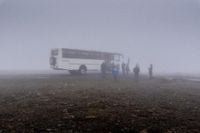On the night of September 4, 2025, tragedy struck the winding mountain roads of Sri Lanka’s Ella region, as a packed tourist bus plunged nearly 1,000 feet into a ravine near the town of Wellawaya. The accident, which occurred about 174 miles (or 280 kilometers) east of Colombo, claimed the lives of 15 people and left 16 others injured, including five children. The incident is already being described as one of the most devastating road disasters in Sri Lanka’s recent memory, casting a shadow over the country’s bustling tourism industry and prompting urgent questions about transportation safety in its most scenic — but perilous — regions, according to multiple news outlets including BNA and The US Sun.
The ill-fated bus was carrying local tourists, many of whom had been exploring the region’s lush tea plantations and hill towns, a popular draw for both Sri Lankans and international travelers. The Ella region is renowned for its breathtaking views, winding passes, and famous landmarks such as the Nine Arches Bridge. On that fateful evening, the bus was making its descent along the Nuwara Eliya-Gampola main road, in an area known as Gerandi Ella, when disaster struck.
According to Sri Lankan police spokesman Fredrick Wootler, a preliminary investigation revealed that the bus was traveling at high speed when it collided with another vehicle. The force of the impact sent the bus careening into safety barriers, which it struck twice with a loud bang before breaking through and plunging down the steep mountainside. The bus’s brake system is believed to have failed after the initial collision, leaving the driver powerless to prevent the catastrophic fall. "The driver was speeding and lost control, colliding with another vehicle and safety barriers before the bus fell off the cliff," Wootler explained, as reported by BNA.
For those on board, the moments before the crash were filled with terror and chaos. Survivors recounted how the bus conductor, sensing imminent danger, shouted at everyone to get low and hold on tight. One survivor told The US Sun, "I was thrown out of the bus through a broken window." The bus’s roof was partially ripped off in the fall, with shattered glass and destroyed seats strewn across the grassy ravine floor. Soldiers and emergency responders rushed to the scene, working through the night in difficult terrain to locate survivors and recover the injured from the wreckage.
Images from the site, shared by several international news organizations, painted a grim picture: the overturned bus lay at the base of the mountain, surrounded by debris, its roof torn away and empty chairs exposed to the open air. The severity of the crash, and the harrowing descent down nearly 1,000 feet, left little doubt about the force of the impact.
The accident is the deadliest in Sri Lanka since May 2025, when 23 passengers lost their lives in a bus crash in Kotmale. The frequency and severity of such incidents have prompted renewed scrutiny of road safety, especially on the country’s mountainous routes that are heavily trafficked by both locals and tourists. The Ella region, in particular, is a magnet for visitors seeking adventure and natural beauty, but the tragedy has highlighted the risks that can come with navigating its challenging roads.
Emergency responders faced significant obstacles in their rescue efforts. The steep, rugged terrain complicated access to the crash site, and the extensive damage to the bus made extricating survivors a time-consuming and dangerous process. Despite these challenges, rescue teams, including Sri Lankan army personnel and local emergency workers, managed to transport the injured to nearby hospitals for urgent treatment.
Authorities have promised a thorough investigation into the causes of the crash and have vowed to implement measures to enhance road safety in the country’s tourist-heavy regions. In a statement, the Sri Lankan government expressed deep condolences to the families of the victims and acknowledged the urgent need to improve safety standards on mountainous roads. "We are committed to ensuring that such tragedies do not repeat," a government spokesperson said, as reported by local media.
The incident has also reignited debate about the adequacy of regulations governing tour bus operations in Sri Lanka. Tourism plays a vital role in the nation’s economy, and the safety of visitors is a top priority for both local authorities and business owners. Many in the tourism sector are now calling for stricter enforcement of speed limits, more rigorous vehicle maintenance checks, and enhanced training for drivers navigating the country’s most hazardous routes.
For the local community in Ella and the broader Wellawaya region, the tragedy has been deeply felt. Businesses that rely on the steady flow of tourists are mourning the loss of life and the impact on the region’s reputation as a safe and welcoming destination. Residents and officials alike have expressed solidarity with the victims’ families, with many participating in memorials and vigils in the days following the crash.
While Sri Lanka is celebrated for its rich history, vibrant culture, and stunning landscapes — from ancient cities to pristine beaches — the events of September 4 have underscored the critical importance of road safety in sustaining the country’s appeal to travelers. As the tourism sector continues to recover and grow, both the government and private operators face mounting pressure to ensure that all transportation services adhere to the highest safety standards.
The lessons from this tragedy are clear: regular vehicle maintenance, strict adherence to speed limits, and comprehensive driver training are essential, especially in high-risk areas like Ella. The hope among officials, residents, and the tourism industry is that, through investigation and reform, such devastating accidents can be prevented in the future, allowing visitors to experience the beauty of Sri Lanka without fear.
As authorities press ahead with their investigation and families mourn their losses, the Ella bus crash stands as a somber reminder of the fragility of life and the enduring need for vigilance on the roads. The story has resonated far beyond the borders of Sri Lanka, prompting travelers and policymakers alike to reflect on what must be done to ensure safety in even the most breathtaking — and treacherous — corners of the world.

